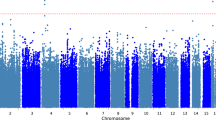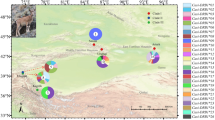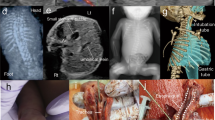Abstract
Postaxial polydactyly (PAP) is the occurrence of one or more extra ulnar or fibular digits or parts of it. In PAP-A, the extra digit is fully developed and articulates with the fifth or an additional metacarpal/metatarsal, while it is rudimentary in PAP-B. Isolated PAP usually segregates as an autosomal dominant trait, with variable expression. Three loci are known for PAP in humans. PAPA1 (including PAP-A/B in one patient) on 7p13 caused by mutations in the GLI3 gene, PAPA2 on 13q21–q32 in a Turkish kindred with PAP-A only, and a third one (PAPA3) in a Chinese family with PAP-A/B on 19p13.1–13.2. We identified a fourth locus in a large Dutch six-generation family with 31 individuals including 11 affecteds. Their phenotype varied from either PAP-A, or PAP-B to PAP-A/B with or without the co-occurence of partial cutaneous syndactyly. We performed a whole-genome search and found linkage between PAP and markers on chromosome 7q. The highest LOD score was 3.34 obtained at D7S1799 and D7S500 with multipoint analysis.
Similar content being viewed by others
Log in or create a free account to read this content
Gain free access to this article, as well as selected content from this journal and more on nature.com
or
References
Temtamy SA, McKusick VA : The genetics of hand malformations. New York: Alan R. Liss, 1978, pp 364–372.
Temtamy SA : Polydactyly, postaxial; in Buyse ML (eds): Birth defects encyclopaedia. Cambridge, MA: Blackwell Scientific, 1990, pp 1397–1398.
Castilla EE, Lugarinho R, da Graca Dutra M, Salgado LJ : Associated anomalies in individuals with polydactyly. Am J Med Genet 1998; 80: 459–465.
Castilla EE, Paz J, Mutchinick O, Munoz E, Giorgiutti E, Gelman Z : Polydactyly: a genetic study in South America. Am J Hum Genet 1973; 25: 405–412.
Scott-Emuakpor AB, Madueke E-DN : The study of genetic variation in Nigeria. Hum Hered 1976; 26: 198–202.
Radhakrishna U, Blouin J-L, Mehenni H et al: Mapping one form of autosomal dominant postaxial polydactyly type A to chromosome 7p15–q11.23 by linkage analysis. Am J Hum Genet 1997; 60: 597–604.
Radhakrishna U, Wild A, Greschik KH, Antanorakis SE : Mutation in GLI3 in postaxial polydactyly type A. Nat Genet 1997; 17: 269–271.
Radhakrishna U, Bornholdt D, Scott HS et al: The phenotypic spectrum of GLI3 morphopathies includes autosomal dominant preaxial polydactyly type-IV and postaxial polydactyly type-A/B; no phenotype prediction from the position of GLI3 mutations. Am J Hum Genet 1999; 65: 645–655.
Akarsu AN, Ozbas F, Kostakoglu N : Mapping of the second locus of postaxial polydactyly type A (PAP-A2) to chromosome 13q21–q32. Am J Hum Genet 1997; 61 (Suppl): A265.
Zhao H, Tian Y, Breedveld G et al: Postaxial polydactyly type A/B (PAP-A/B) is linked to chromosome 19 p13.1–13.2 in a Chinese kindred. Eur J Hum Genet 2002; 10: 162–166.
Miller SA, Dykes DD, Polesky HF : A simple salting out procedure for extracting DNA from human nucleated cells. Nucleic Acids Res 1988; 16: 1215.
Lathrop GM, Laouel JM : Easy calculations of lodscores and genetic risks on a small computer. Am J Hum Genet 1984; 36: 460–465.
Vaessen N, Heutink P, Houwing-Duistermaat JJ et al: A genome-wide search for linkage-disequilibrium with type 1 diabetes in a recent genetically isolated population from the Netherlands. Diabetes 2002; 51: 856–859.
Kucheira K, Kenue RK, Taneja N : An Indian family with postaxial polydactyly in four generations. Clin Genet 1981; 20: 36–39.
Goodman FR : Limb malformations and the human HOX genes. Am J Med Genet 2002; 112: 256–265.
Rayan GN, Frey B : Ulnar polydactyly. Plast Reconstr Surg 2001; 107: 1455–1457.
Fawcett D, Pasceri P, Fraser R, Colbert M, Rossant J, Giguere V : Postaxial polydactyly in forelimbs of CRABP-II mutant mice. Development 1995; 121: 671–679.
Woolf CM, Myrianthopoulos NC : Polydactyly in American negroes and whites. Am J Hum Genet 1973; 25: 397–404.
Woolf CM, Woolf R : A genetic study of polydactyly in Utah. Am J Hum Genet 1970; 22: 75–88.
Ventruto V, Theo G, Celona A et al: A and B postaxial polydactyly in two members of the same family. Clin Genet 1980; 18: 342–347.
Parr B, McMahon AP . Dorsalizing signal Wnt-7a required for normal polarity of D–V and A–P axes of mouse limb. Nature 1995; 374: 631–640.
Cygan JA, Johnson RL, McMahon AP : Novel regulatory interactions revealed by studies of murine limb pattern in Wnt-7a and En-1 mutants. Development 1997; 124: 5021–5032.
Acknowledgements
We acknowledge the family for their cooperation, R Koppenol for his work on the illustrations. We also acknowledge the Foundation of Clinical Genetics Rotterdam for their financial support.
Author information
Authors and Affiliations
Corresponding author
Rights and permissions
About this article
Cite this article
Galjaard, RJ., Smits, A., Tuerlings, J. et al. A new locus for postaxial polydactyly type A/B on chromosome 7q21–q34. Eur J Hum Genet 11, 409–415 (2003). https://doi.org/10.1038/sj.ejhg.5200982
Received:
Revised:
Accepted:
Published:
Issue date:
DOI: https://doi.org/10.1038/sj.ejhg.5200982
Keywords
This article is cited by
-
The molecular genetics of human appendicular skeleton
Molecular Genetics and Genomics (2022)
-
Behandlung angeborener Handfehlbildungen
Pädiatrie & Pädologie (2013)
-
Genetic mapping of an autosomal recessive postaxial polydactyly type A to chromosome 13q13.3–q21.2 and screening of the candidate genes
Human Genetics (2012)



